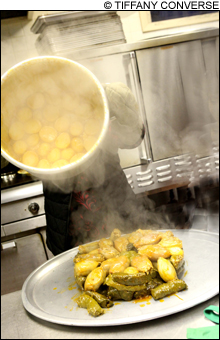
RISING STEAM The dolmas emerge from the pot. |
The kitchen of St. Pius X Church at the north corner of Payson Park (492 Ocean Ave, Portland) was particularly steamy on the muggy, unusually hot night of October 1. Forty people were inaugurating a new international cooking class series taught by refugees, a project of the Catholic Charities Maine Refugee & Immigration Services. The head cook was a woman from Iraq. She'd been an architect there, working for the US government in reconfiguring Saddam Hussein's palaces for new uses, but had to flee because her colleagues and their families were being kidnapped and killed. She'd lost one baby. She had two children left. She'd barely survived losing blood for seven hours after an explosion. It was time to leave.
The steam erupting out of large silver pots and the general hustle required in feeding 40 with culinary commentary (in a second language!) had her repositioning her scarf again and again behind her shoulders. It's hard to say, with four wonderful dishes and all the secrets behind them revealed to me throughout the night, what my favorite part was, but I think it's that there was a Muslim woman in a Catholic church teaching a cooking lesson, and no one had any bones about it. The next day, I mentioned this to the cook and she said, "Since we are believing in the same thing, many kindness in charities and helping people, I don't feel there is much difference: Christian, Muslim. The main thing is teaching people to help other people, each one support another people."
In the kitchen 10 students were helping her by dicing tomatoes, picking the leaves off parsley stems, and cutting bell peppers into chunks. "Like this?" one man asked, pointing to his pile of fresh mint leaves. They were preparing fattoush, a fresh, crunchy, incredibly colorful salad, which would also include romaine lettuce, shredded carrot, chunks of cucumber, green onion, toasted crunchy pita, a dressing of equal parts lemon juice and olive oil, and a special spice called sumac.
When the red lentil soup was being served, I sat next to a young girl from Iraq. She had black hair, dark eyes, and lashes that beauty magazines advertise. Just 9 years old, she'd been the assistant cook, helping to roll 120 dolmas. She'd used grape leaves as wrappers, but also boiled red and yellow onion skins, and chard leaves de-stemmed and dipped in hot water. As the head cook called for spices in Arabic, the young girl presented them to the audience to smell and see up close. Sumac smells like classic BBQ sauce, and adds tang, in dried spice form, that's about half the power of cranberry. Citric acid looks like bright white course salt. It was responsible for the subtle tang in the soup.
What did the Iraqi girl miss most about Iraq? "Family," she answered. She left behind aunts and uncles and a whole bunch of cousins whom she might never see again. She missed her bigger house and flower garden of irises and roses. But she didn't miss having to find her way home on foot after her school bus stopped behind a bomb explosion or being startled in the middle of the night by gunshots and hiding in her mother's room. I asked her what the most amazing thing here was. "In Iraq," she answered, "there is fighting. The breeze comes with dust. Here, the breeze is clean."